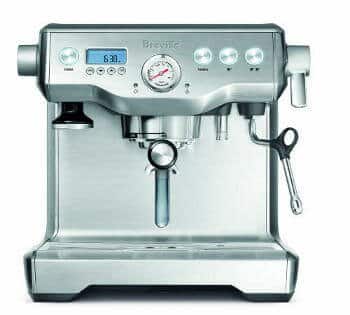If you are looking to be able to make a great tasting espresso and have flexibility to do short and long espressos and want the ability to fine-tune your espresso, a semi-automatic espresso machine is what you are looking for. But, not all semi-automatic espresso machines are the same. The will vary in features, quality, durability, and cost. We have compiled a list of features to look for in choosing the best semi-automatic espresso machine for you and also our recommendations.
Considerations When Buying a Semi-Automatic Espresso Machine
Boilers
The main purpose of a semi-automatic espresso machine is to have a consistent water temperature and pressure but allow the user the flexibility to control the amount of water and the flow through the coffee. By having a strong heat source, it will be easier and faster to create a good tasting cup of espresso. Therefore, the most important parts on semi-automatic espresso machines are the electric pump and the boiler. On different machines there will be a variety of setups for number of boilers and use of the boilers.
The majority of inexpensive machines will have a single boiler that will be used for both the water for the coffee and for the steaming wand. They will also use a single thermostat for the water temperature. This means, that you cannot brew your espresso and steam the milk at the same time. You will heat the water for the coffee, brew the coffee, heat the water at a higher temperature for the steaming of the milk, and then steam the milk. For most people, this is not a problem and fits the need for a home espresso maker since the time between brewing the espresso and heating the water for the steam is typically 45 – 75 seconds.
Some more expensive machines will have a single-boiler, a heat-exchanger, and a larger boiler. The boiler heats the water to a temperature ideal to steam milk. The heat exchanger heats the water to the group head for water heated to an ideal temperature for the coffee. This allows simultaneous steaming and espresso brewing.
At the high end of the price range are dual-boiler system machines. These will have two separate boilers allowing you to brew and steam at the same time. Note that most of these types of machines are typically for small cafes and many require commercial electrical wiring. But, the Breville BES900XL does have a dual boiler and is reasonably priced.
Regardless of the number of boilers, you will also have a pump that produces the high bars of pressure necessary. The number of bars does get used for marketing and some companies will state that their machines can reach a high number of bars such as 15 bars. But, all you need to worry about is that it can go to 9 bars of which most machines made by well-known companies will have. Anything greater than 9 bars is not necessary to make a good espresso.
When choosing your espresso machine, you will also want to look at the materials that are used on the boiler. Having and maintaining proper water temperature is very important in producing a good cup of espresso. A heavy grade brass boiler will work much better than a thin stainless steel.
Portafilter Handle
The portafilter handle is the handle that the filter and coffee are placed in and connected to the espresso machine. Ideally, this is made of forged brass to give better durability than aluminum construction. Also, the brass will retain heat better.
Steaming Wand / Hot Water
Most semi-automatic espresso machines will have a wand for steaming milk. The key to steaming milk is the temperature of the steam. Thermoblock systems will heat the water for the steam quicker. But, keep your eye on the boiler and the quality of the metals used.
Some espresso machines will have the capability to produce hot water. This is often done by using the steam wand and flipping a switch. This can be handy if you want to make a tea or to add hot water for an Americano or other drink requiring hot water. Note that while this feature seems nice, you can get the same results by simply leaving the portafilter handle and an empty clean filter and running the water like you would an espresso.
Water Reservoir
Different machines will have different size water reservoirs. This is mostly a personal preference. If you tend to serve a large number of people, a larger reservoir can be nice so that you are not constantly refilling your water.
Grinder
Most semi-automatic espresso machines do not have a coffee bean grinder. This will typically be found on fully automatic espresso machines since they are designed for you to simply push a button and have espresso made for you. If they do have a grinder, make sure that it is a burr grinder since it will properly grind the beans and not burn them during the grinding process. Also, you will want the coarseness of the grind to be customizable.
Additional Features
Additional functions you will find on a different semi-automatic espresso machines includes programmable functions such as water volume control, thermometer, shot clock, and others. Naturally, you should also consider how much counter space you have available.
Cost
Semi-Automatic espresso machines come in a wide range of prices. The key differences will be in the quality of the parts used which not only will affect how well those parts work but also how durable those parts are. The machines will also vary in features. Note that you do not need to spend a lot of money for a good machine.
